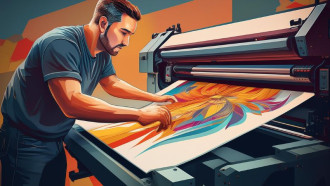Visual management is a modern approach to optimizing business processes that allows companies to increase efficiency, improve communication, and reduce waste. In the age of digitalization and rapid information flow, more and more enterprises are turning to visual management tools such as lean boards, informational signs, or safety labels to streamline their operations, enhance team safety, and gain a competitive edge.
In this article, we will introduce you to the world of visual management, present its basic principles, and show you how it can benefit your company. This is just the beginning of our series of articles on this topic, which will help you understand and implement the best practices of visual management in your enterprise.
Definition of Visual Management
Visual management is an organizational method that uses visual signals and tools to effectively convey information and manage processes and operations within companies. The key goal of visual management is to improve communication and understanding of actions and tasks at every level of the organization, leading to increased efficiency and the elimination of waste.
Visual management encompasses a wide range of tools, such as dry-erase visual boards, magnetic boards, often with custom printing, infographics, visual indicators, and process maps. These elements help in quickly and intuitively conveying information, which is particularly important in a dynamic business environment where rapid response and adaptation are crucial.
History and Development of Visual Management
The origins of visual management date back to the early 20th century when manufacturing companies began introducing the first simple visual tools, such as control boards and diagrams. One of the pioneers of visual management was Henry Ford, who introduced a system of visual signals in his factory to monitor the production process and streamline the assembly line.
In the 1950s and 1960s, the concept of Kaizen and Lean Management was developed in Japan, heavily relying on visual management. Japanese companies such as Toyota started using advanced visual tools for production management and quality control, contributing to their global success.
Since then, visual management has evolved and expanded into various industries and sectors. Modern technologies such as digital boards, process management software, and analytical tools enable even more effective and precise visual management.
The Importance of Visual Management in Modern Business
In today's dynamic and complex business environment, visual management has become an essential tool for many organizations. Transparency and quick access to key information are crucial for making fast and accurate decisions. Visual management helps achieve these goals by:
- Improving communication: Visual tools allow employees at all organizational levels to quickly understand current priorities, progress, and issues, reducing the risk of misunderstandings and errors.
- Increasing efficiency: Clear and understandable visual signals help in quickly identifying and resolving problems, contributing to operational efficiency and streamlining contact.
- Supporting engagement: Employees with access to visual management tools feel more engaged and responsible for their work outcomes, translating into better motivation and performance.
- Reducing waste: By visualizing processes and indicators, companies can more easily identify and eliminate waste in various areas of their operations, leading to cost and resource savings.
In summary, visual management is not only a tool supporting operational efficiency but also a key element of management strategy in modern enterprises. Its role will continue to grow with technological advancements and the increasing need for real-time access to information.
Basic Elements of Visual Management
What Are Visual Tools?
Visual tools are a variety of techniques and instruments used to present information visually, making it easier to understand, analyze, and use. These tools aim to present key data and processes in an intuitive way, enabling faster decision-making and more effective management of operations. In visual management, these tools can include informational boards, visual indicators, diagrams, process maps, infographics, and digital technologies such as data visualization software.
Types of Visual Tools
Visual Boards
Visual boards are physical surfaces or digital displays (information displayed on LCD monitors) that present information about various aspects of an organization's operations. These can be dry-erase boards, cork boards, planners, Kanban boards, or electronic displays and interactive screens. An example of a dry-erase visual board might present data on performance, schedules, project statuses, KPI indicators, and more.
Visual Indicators
Visual indicators are graphical elements such as colors, symbols, icons that signal the status or level of certain parameters. Examples include color indicators on machines (green - operating, red - malfunction), warning icons on safety boards, or charts showing inventory levels or project progress.
Infographics
Infographics are graphical representations of data and information that simplify the understanding of complex topics by visually presenting key points. Infographics can include diagrams, charts, illustrations, and text, creating a cohesive and easy-to-understand message.
Process Maps
Process maps are graphical representations of the sequence of steps in a business process. They help identify individual stages, dependencies between them, and potential areas for improvement. Process maps can be created as flowcharts, block diagrams, or SIPOC (Suppliers, Inputs, Process, Outputs, Customers) diagrams.
Advantages of Using Visual Management
The basic elements of visual management include a variety of tools and techniques that support effective information transfer and process management. Visual boards, visual indicators, infographics, and process maps are just some of the tools that can be used to improve transparency, communication, decision-making, employee engagement, and waste reduction. Implementing visual management can bring significant benefits to organizations, increasing their efficiency and competitiveness in the market.
- Increasing transparency: One of the main advantages of visual management is increasing the transparency of information and processes. With visual tools, employees at all levels of the organization can quickly and easily understand key data, minimizing the risk of misunderstandings and errors.
- Facilitating communication: Visual tools facilitate communication between team members and departments. Information presented visually is more intuitive and easier to absorb than text reports, promoting better understanding and collaboration.
- Faster decision-making: With clear and easily accessible information, visual management enables faster decision-making. Management and employees can quickly identify problems and take appropriate actions, contributing to increased operational efficiency.
- Increasing employee engagement: Visual management tools help employees better understand their roles and responsibilities, increasing their engagement and motivation to work. Employees who see visual representations of their achievements and progress are more motivated to continue working.
- Reducing waste: By identifying and eliminating waste in business processes, visual management contributes to cost and resource savings. Visual tools help quickly identify inefficiencies and implement improvements.
Benefits of Implementing Visual Management in a Company
Improving Internal Communication
Visual management significantly improves internal communication within an organization. Visual tools and techniques enable clear and transparent information transfer, minimizing the risk of misunderstandings and errors. Employees can quickly understand the current status of projects, progress, and any significant changes. As a result, all team members are up-to-date with the most important information, facilitating collaboration and coordination of activities.
Example: In a manufacturing plant, a visual board placed in a central location can inform employees about the current state of production, inventory levels, and any machine failures. This allows employees to quickly respond to changes and take appropriate actions.
Increasing Process Efficiency
Implementing visual management contributes to increasing process efficiency within an organization. Visual presentation of processes and data allows for quicker identification of problems and improvements. Employees can easily spot bottlenecks, inefficiencies, and waste, enabling quick corrective actions.
Example: In a logistics company, a process map can help identify delays in deliveries and areas requiring optimization. With a visual representation of the logistics process, managers can quickly implement changes to improve delivery efficiency.
Minimizing Errors and Mistakes
Visual management helps minimize errors and mistakes by clearly and understandably presenting information. Visual tools such as color indicators, warning icons, and diagrams enable employees to quickly recognize irregularities and take appropriate actions. This allows organizations to avoid costly errors and improve the quality of their products and services.
Example: In a research laboratory, using visual indicators on laboratory equipment can help quickly identify issues such as incorrect temperature or pressure settings. This helps researchers avoid errors in experiments and ensure accurate results.
Motivation and Employee Engagement
Visual management tools support employee motivation and engagement. Clear and transparent presentation of goals, results, and work progress makes employees feel more connected to the organization and responsible for their tasks. Visual tools also enable quick and regular feedback, supporting development and job satisfaction.
Example: In a sales office, a visual board displaying each team member's sales results can motivate employees to achieve better results. Regular updates and feedback help employees understand which actions yield the best results.
Facilitating Monitoring and Evaluation of Results
Visual management enables easy monitoring and evaluation of results. Visual representation of key performance indicators (KPIs) and project progress allows for quick identification of areas needing improvement. Managers can easily track achieved results, facilitating decision-making and planning further actions.
Example: In a manufacturing company, a visual board displaying performance indicators such as the number of produced units, defect levels, and downtime allows managers to monitor production efficiency and take appropriate actions to improve it.
Reducing Waste
One of the main goals of visual management is to reduce waste in business processes. Visual tools help identify inefficiencies, excesses, and other forms of waste, allowing for corrective actions and process optimization. This increases operational efficiency and reduces costs.
Example: In a manufacturing company, a process map can help identify excesses in raw material inventory and production delays. With a visual representation of processes, managers can implement changes to reduce waste and improve production efficiency.
Supporting Decision-Making
Visual management can provide managers and employees with the necessary information in a transparent manner, facilitating accurate decision-making. Visual tools such as diagrams, charts, and dry-erase and magnetic informational boards allow for quick understanding of the situation and data analysis, which is crucial in a dynamic business environment.
Example: In a service company, a visual dashboard presenting data on customer satisfaction, service levels, and financial results can help managers make decisions regarding customer service strategy and process optimization.
Increasing Competitiveness
By implementing visual management, organizations can improve their operational efficiency, product and service quality, and customer satisfaction. All this contributes to increased market competitiveness. Companies that effectively utilize visual management are better prepared to respond to market changes and achieve their business goals.
For example, in a technology company, visual management of R&D projects can help in faster introduction of innovations and products to the market, increasing the company's competitiveness and its ability to compete with other players in the industry.
Conclusion
Implementing visual management brings numerous benefits that translate into improved operational efficiency, product and service quality, and employee and customer satisfaction. Improved communication, increased process efficiency, error minimization, employee motivation, easier result monitoring, waste reduction, decision-making support, and increased competitiveness are just some of the advantages that make visual management an essential element of modern management strategies. By implementing it, organizations can achieve better results and more effectively achieve their business goals.

Kinga
product manager at Wallyboards
Kinga is the heart of our team – she’s the one you’ll most often speak to when you write or call Wallyboards. With passion, she helps customers choose the perfect products for their home or office, sharing her knowledge about features and practical uses. Her experience and dedication mean even the most technical questions get quick and accurate answers.







